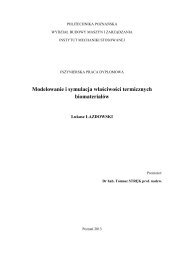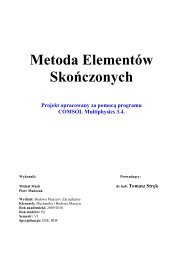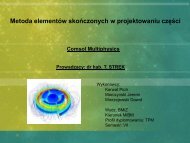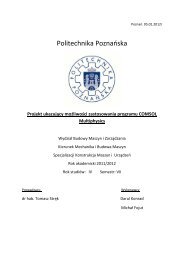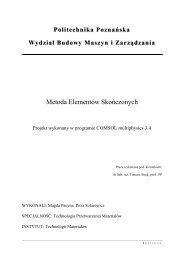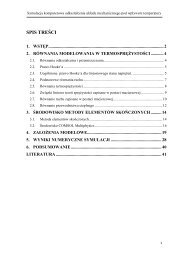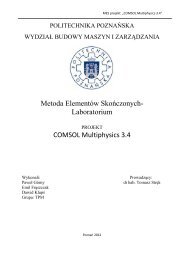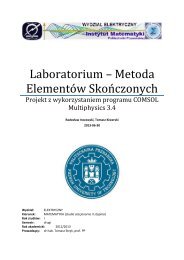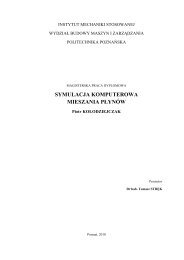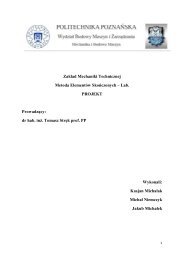Lithium-Ion Battery Simulation for Greener Ford Vehicles
Lithium-Ion Battery Simulation for Greener Ford Vehicles
Lithium-Ion Battery Simulation for Greener Ford Vehicles
You also want an ePaper? Increase the reach of your titles
YUMPU automatically turns print PDFs into web optimized ePapers that Google loves.
HVAC<br />
SPACECLAIM CORP., CONCORD, MA<br />
3D Direct Modeling Streamlines Micro-Cogeneration System<br />
Design and Analysis Processes<br />
Multiphysics software is used to analyze and optimize heat conduction and thermal structure interaction.<br />
SPACECLAIM CORP., CONCORD, MASSACHUSETTS<br />
SYNGAS specializes in thermal and<br />
micro-thermal technology, and designs<br />
and analyzes pre-production heating,<br />
cooling, and thermal insulation systems<br />
<strong>for</strong> a variety of applications. They<br />
provide engineering support to research<br />
centers and fuel cell manufacturers working<br />
with complex catalyst and hydrogen<br />
fuel cells <strong>for</strong> micro-generation systems.<br />
Micro-cogeneration systems are refined<br />
to be as effective as possible at<br />
utilizing fuel cell power. These micro-cogeneration<br />
systems are built to provide<br />
efficient heating and cooling systems <strong>for</strong><br />
home and commercial use by converting<br />
materials like kerosene or natural gas<br />
into hydrogen, which then powers the<br />
fuel cell and manages the energy flow <strong>for</strong><br />
either heating or cooling. In homes, these<br />
systems are used <strong>for</strong> both heating and<br />
air conditioning applications. In commercial<br />
applications such as airplanes,<br />
there is never any shortage of heat due<br />
to the engines, and the systems are used<br />
to provide much needed air conditioning<br />
to keep passengers com<strong>for</strong>table.<br />
The company uses SpaceClaim and<br />
COMSOL software to analyze and optimize<br />
heat conduction and thermal<br />
COMSOL Results of Heat Exchange and chemical<br />
reactions that occur while re<strong>for</strong>ming hydrocarbons.<br />
This cross-section shows the temperature<br />
field and heat flux between two reactors.<br />
structure interaction. In order<br />
to design systems that get<br />
the most out of fuel cells, the<br />
company needs to constantly<br />
iterate the 3D geometry and<br />
test it in COMSOL to figure<br />
out what works and what<br />
doesn’t. Previously, the company<br />
had to request edits from<br />
trained CAD experts or struggle<br />
with CAD on their own,<br />
which slowed implementation<br />
of ideas, consumed valuable<br />
time, and reduced the ability<br />
to serve new customers.<br />
In search of a better solution, the company<br />
found SpaceClaim and saw that it<br />
was being utilized by numerous COM-<br />
SOL users as a tool <strong>for</strong> analysis preparation<br />
and <strong>for</strong> 3D geometry editing and<br />
creation. SYNGAS uses SpaceClaim to<br />
analyze and edit more designs, enabling<br />
them to improve and increase the quality<br />
and the rate of output.<br />
SpaceClaim imports geometry directly<br />
from SolidWorks and other CAD systems,<br />
significantly easing the process<br />
of making edits and updates to existing<br />
data. The company can easily de-feature<br />
CAD geometries — removing any parts,<br />
faces, or holes that are irrelevant to<br />
analysis — and then move to COMSOL<br />
to test the quality and efficiency of the<br />
model, and, if required, return the model<br />
to the native CAD system.<br />
For concept modeling, SYNGAS is also<br />
developing new ideas in SpaceClaim.<br />
SYNGAS’s complex models, many of<br />
which were originally created in Solid-<br />
Works, can be directly opened in Space-<br />
Claim, which enables all the disparate<br />
parts to be merged into one solid to drive<br />
the analysis. In these assemblies, there<br />
are often numerous instances of small<br />
features such as screws in holes, which<br />
are problematic <strong>for</strong> COMSOL. Space-<br />
SpaceClaim Model of the Reactors and Heat Exchangers <strong>for</strong><br />
a compact re<strong>for</strong>ming system that produces hydrogen <strong>for</strong> a<br />
100kW fuel cell stack.<br />
Claim is used to first delete the screw<br />
design and then fill in the hole by extending<br />
surrounding material. Additionally,<br />
many SYNGAS models are drawn with<br />
fillets or round edges, which are often<br />
necessary to avoid stress concentrations<br />
at the straight intersections but are unnecessary<br />
<strong>for</strong> simulation. SpaceClaim<br />
allows modification of the drawing and<br />
the ability to change the angles to make<br />
sure everything is properly arranged<br />
<strong>for</strong> analysis.<br />
SYNGAS focuses on conceptualization,<br />
not production, and a fully featured<br />
parametric CAD system was not<br />
the right tool to create and simulate<br />
concepts. Without intensive and timeconsuming<br />
training, users became proficient<br />
with SpaceClaim’s 3D Direct Modeling<br />
tools and were able to immediately<br />
concentrate their energy on their areas<br />
of expertise. The company’s work is<br />
not to draw plans <strong>for</strong> machining, but<br />
to imagine and conceive new systems,<br />
which is done efficiently and effectively<br />
with SpaceClaim.<br />
This work was done by Paul Gateau<br />
of SYNGAS using software from<br />
SpaceClaim and COMSOL. For more<br />
in<strong>for</strong>mation, visit http://info.hotims.com/<br />
28057-151. ■<br />
6 // C O M S O L N E W S 2 0 1 1<br />
➮<br />
Cov ToC + – A<br />
➭<br />
06 CN SpaceClaim 2011.indd 6 5/13/11 9:55 AM



